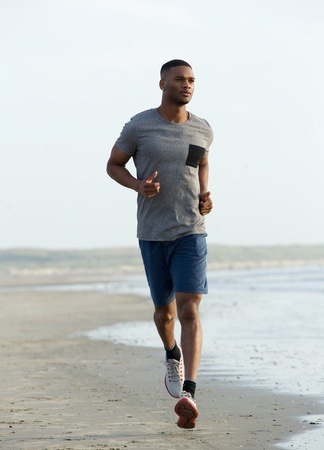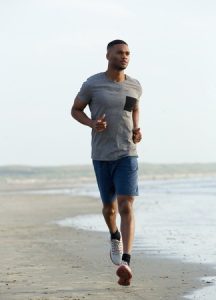
My recent visit to Myrtle Beach was filled with beautiful scenery, a bit of adventure, and a good deal of great food. Admittedly, the great food is what turned my mind to exercising, and, namely, running. An inviting, pancake-flat, paved path started a quarter mile from my accommodations and passed through a manicured park with a glittering lake as the centerpiece.
There’s no denying the convenience and relatively low impact of the path’s location and profile, but the Atlantic waited with gently cresting waves, sun-warmed water, and sand. There was no real contest. What better way to create a win-win than a run on the beach? Great exercise while taking in the views! So kick off those shoes and get started right? Pardon the pun, but, not so fast!
Here are 3 fast things you need to know about successful and injury-free beach running.
 Know That Beach Running Uses More Energy, so beginners shouldn’t be surprised to be humbled after just a few miles. In fact, it’s recommended to plan a short distance for a first-time beach run. Sand, even the packed sand at the shoreline, doesn’t offer the help that concrete does. On foot strike, the sand sinks underneath the foot. Plus, the sand doesn’t rebound like that nice path around the lake would, which means that muscles like glutes and quadriceps must work harder to repeat those strides.
Know That Beach Running Uses More Energy, so beginners shouldn’t be surprised to be humbled after just a few miles. In fact, it’s recommended to plan a short distance for a first-time beach run. Sand, even the packed sand at the shoreline, doesn’t offer the help that concrete does. On foot strike, the sand sinks underneath the foot. Plus, the sand doesn’t rebound like that nice path around the lake would, which means that muscles like glutes and quadriceps must work harder to repeat those strides.
Know That the Necessity for Shoes is Real, because picking up seashells is wonderful as long as it’s not done by embedding them in skin. To put it shortly, it’s best to wear shoes on the beach for many of the same reasons it’s best to wear them running elsewhere. But there’s another reason. True, impact on sand makes for a softer landing, but that’s precisely why injury can occur. Without proper support, the change in stride and the extra workload on muscles can lead to plantar fasciitis, ankle sprain, or hip-flexor damage. As far as the type of running shoe to wear for beach running, keep in mind that trail shoes offers better grip than traditional running shoes and could be the way to go.
Know How to Prevent Injury. Because of the things already mentioned, extra care should be taken on the beach. Try running close to the shoreline, where the sand is wet and packed down. Don’t do too much too soon. Understandably, vacation time might be short, but it’s best to start off with a short run of maybe 15-20 minutes and add 5 minutes on the subsequent run. Remember, those are just suggested times. Listen to your body, and if you feel any “complaints,” call it a day and pick it up later. Time to simply enjoy the view.






